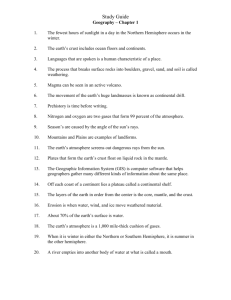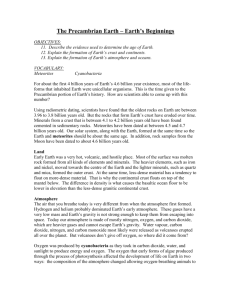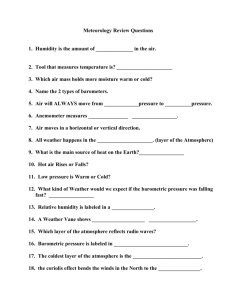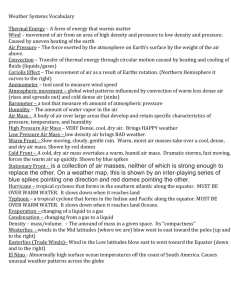95KB - NZQA
advertisement
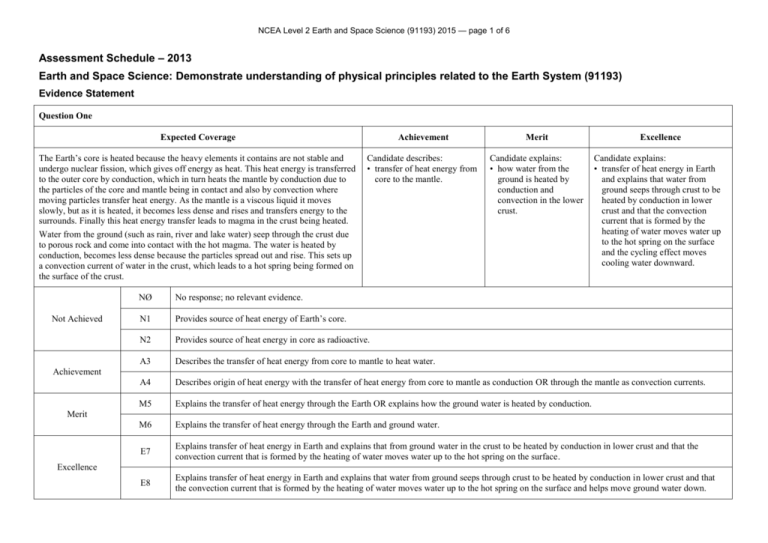
NCEA Level 2 Earth and Space Science (91193) 2015 — page 1 of 6 Assessment Schedule – 2013 Earth and Space Science: Demonstrate understanding of physical principles related to the Earth System (91193) Evidence Statement Question One Expected Coverage Achievement Merit The Earth’s core is heated because the heavy elements it contains are not stable and undergo nuclear fission, which gives off energy as heat. This heat energy is transferred to the outer core by conduction, which in turn heats the mantle by conduction due to the particles of the core and mantle being in contact and also by convection where moving particles transfer heat energy. As the mantle is a viscous liquid it moves slowly, but as it is heated, it becomes less dense and rises and transfers energy to the surrounds. Finally this heat energy transfer leads to magma in the crust being heated. Water from the ground (such as rain, river and lake water) seep through the crust due to porous rock and come into contact with the hot magma. The water is heated by conduction, becomes less dense because the particles spread out and rise. This sets up a convection current of water in the crust, which leads to a hot spring being formed on the surface of the crust. Candidate describes: • transfer of heat energy from core to the mantle. Candidate explains: • how water from the ground is heated by conduction and convection in the lower crust. Not Achieved Excellence Candidate explains: • transfer of heat energy in Earth and explains that water from ground seeps through crust to be heated by conduction in lower crust and that the convection current that is formed by the heating of water moves water up to the hot spring on the surface and the cycling effect moves cooling water downward. NØ No response; no relevant evidence. N1 Provides source of heat energy of Earth’s core. N2 Provides source of heat energy in core as radioactive. A3 Describes the transfer of heat energy from core to mantle to heat water. A4 Describes origin of heat energy with the transfer of heat energy from core to mantle as conduction OR through the mantle as convection currents. M5 Explains the transfer of heat energy through the Earth OR explains how the ground water is heated by conduction. M6 Explains the transfer of heat energy through the Earth and ground water. E7 Explains transfer of heat energy in Earth and explains that from ground water in the crust to be heated by conduction in lower crust and that the convection current that is formed by the heating of water moves water up to the hot spring on the surface. E8 Explains transfer of heat energy in Earth and explains that water from ground seeps through crust to be heated by conduction in lower crust and that the convection current that is formed by the heating of water moves water up to the hot spring on the surface and helps move ground water down. Achievement Merit Excellence NCEA Level 2 Earth and Space Science (91193) 2015 — page 2 of 6 Question Two Expected Coverage Achievement Merit Excellence A large volcanic eruption can mean a drop in the mean temperature of the earth in the years following the eruption. A volcanic eruption can eject lots of ash in to the air that is different sizes. Heavy ash particles will not affect the atmosphere long term, as they will drop down to earth quickly due to gravity. But dust-sized particles of ash can cause reflection of heat radiation from the Sun. If the ash is in the lower part of the atmosphere, it will lead to a reduction in heat radiation getting through to the surface. In the upper part of the atmosphere, ash particles have more of an effect because the particles remain in the atmosphere for longer, and so reflect solar radiation back into space and allow less transmission of the solar radiation through to the surface of the earth. Carbon dioxide and sulfur dioxide are greenhouse gases. They allow heat from the sun to be transmitted through to the Earth’s surface but do not allow the re-radiated heat from the Earth’s surface to be reflected back into space, and so they lead to the temperature of the earth heating up. However, a volcanic eruption will not eject enough carbon dioxide and sulfur dioxide into the air to cause an overall appreciable difference in the amounts of both of these gases in the atmosphere because one volcano erupting will not increase the amounts of these gases in the entire atmosphere very much at all because there are large amounts of these greenhouse gases in the air already. Candidate: • describes that temperature of earth after volcanic eruption will change. • describes that dust in atmosphere will reflect/trap solar radiation from reaching earth surface. • describes the effect of greenhouse gases on the temperature of the earth. Candidate explains: • how size and / or location of dust particles affects reflection of solar radiation. • the effect of greenhouse gases on the temperature of the Earth. Candidate: • explains how size and location of dust particles affects reflection of solar radiation and discusses how this can be a world-wide phenomenon. • explains how amount of gases emitted from volcano is very small compared to amount of gases in atmosphere and so does not affect temperature of earth after a volcanic eruption. Not Achieved Achievement NØ No response; no relevant evidence. N1 States that temperature of Earth will change because of increase in greenhouse gas emissions. N2 States that temperature of Earth will change due to the effect of ash. A3 • Describes that temperature of Earth will change after volcanic eruption because dust will reflect/trap solar radiation from reaching Earth’s surface. OR • Describes the effect of greenhouse gases on the temperature of the Earth. NCEA Level 2 Earth and Space Science (91193) 2015 — page 3 of 6 A4 • Describes that temperature of Earth will change after volcanic eruption because dust will reflect/trap solar radiation from reaching Earth’s surface. AND • Describes the effect of greenhouse gases on the temperature of the Earth. M5 • Explains how particles in the atmosphere affect reflection of solar radiation. OR • Explains the effect of the greenhouse gases on temperature of the Earth. M6 • Explains how particles in the atmosphere affect reflection of solar radiation. AND • Explains the effect of the greenhouse gases on temperature of the Earth. E7 Discusses ONE of the following: • how size and location of ash/dust particles affects reflection of solar radiation and explains how this can be a world-wide phenomenon • how amount of gases emitted from volcano is very small compared to amount of gases in atmosphere and so does not affect temperature of Earth after a volcanic eruption in the way large amounts of greenhouse gases would do. E8 Discusses BOTH of: • how size and location of ash/dust particles affects reflection of solar radiation and explains how this can be a world-wide phenomenon • how amount of gases emitted from volcano is very small compared to amount of gases in atmosphere and so does not affect temperature of Earth after a volcanic eruption in the way large amounts of greenhouse gases would do. Merit Excellence NCEA Level 2 Earth and Space Science (91193) 2015 — page 4 of 6 Question Three Expected Coverage The Gulf Stream originates close to the Equator. This is because at the Equator, the Sun’s rays are concentrated and are spread over a smaller area. This means the tropical oceans receive more heat energy from the Sun (than higher latitude oceans) and therefore will absorb more radiant energy and have higher temperatures. The ocean absorbs and stores solar energy from the Sun. The Gulf Stream heads north and acts as a conveyer belt of fastmoving warm water. As this warm water tracks northward there is heat exchange between the warm ocean surface and the cooler overlying atmosphere. This transfer is called conduction (conduction occurs when two objects at different temperatures are in contact with each other. Heat flows from the warmer to the cooler object until they are both at the same temperature. Where the two objects touch, the faster-moving molecules of the warmer object collide with the slower moving molecules of the cooler object. As they collide, the faster molecules give up some of their energy to the slower molecules. The slower molecules gain more thermal energy and collide with other molecules in the cooler object. This process continues until heat energy from the warmer object spreads throughout the cooler object and it increases the temperature of the overlying air. If this warm air is blown onto land, it can increase the temperature of the landmass and moderates the region’s climate. This is what happens to Stornoway in the United Kingdom. Stornoway receives air that has blown across the warm waters of the Gulf Stream. This moist warm air can directly warm the land near the coast. In comparison, Hopedale’s climate is not moderated by the Gulf Stream and therefore does not receive warm air. This means Hopedale’s temperatures are generally several degrees lower than Stornoway’s. Achievement Describes TWO of: • how current originates near the Equator • how Gulf Stream is a warm current • how ocean influences land temperature. Merit Explains TWO of: • how current originates at the Equator • how Gulf Stream is a warm current • how warm current influences land temperature. Excellence Explains in detail ONE of: • how Gulf Stream is warm and originates at the Equator and travels north east, with reasons • how the temperatures of Hopedale and Stornoway are different despite being at approximately the distance from the equator, with reasons. NCEA Level 2 Earth and Space Science (91193) 2015 — page 5 of 6 Greater area to heat up due to land curvature More atmosphere to pass through North Pole here osp atm Equator Less atmosphere to pass through Very hot because the sun’s rays are concentrated on small area adapted from: http://cgz.e2bn.net/e2bn/leas/c99/schools/cgz/accounts/staff/rchamber s/GeoBytes/Key%20Stage%203/Year%209/Natural%20Environments /Climate/what_factors_affect_climate.htm NØ No response; no relevant evidence. N1 States ONE of: • how current originates near the Equator or Arctic • how Gulf Stream is a warm current • how ocean warms or cools the atmosphere / land. N2 States TWO of: • how current originates near the Equator or the Arctic • how Gulf Stream is a warm current • how ocean warms or cools the atmosphere / land. A3 Describes ONE of: • how current originates near the Equator • how Gulf Stream is a warm current • how ocean influences land temperature. A4 Describes TWO of: • how current originates near the Equator • how Gulf Stream is a warm current Not Achieved Achievement NCEA Level 2 Earth and Space Science (91193) 2015 — page 6 of 6 • how ocean influences land temperature. M5 Explains ONE of: • how current originates at the Equator • how Gulf Stream is a warm current • how warm current heats the land or atmosphere. M6 Explains TWO of: • how current originates at the Equator • how Gulf Stream is a warm current • how warm current heats the land or atmosphere. E7 Explains in detail with reasons: EITHER • Why the Gulf Stream is warm and originates near the equator. OR • How the ocean currents influence the temperatures of Hopedale and Stornoway. E8 Explains in detail with reasons: • Why the Gulf Stream is warm and originates at the equator. AND • How the ocean currents influence the temperatures of Hopedale and Stornoway. Merit Excellence Judgement Statement Score range Not Achieved Achievement Achievement with Merit Achievement with Excellence 0–6 7 – 12 13 – 18 19 – 24

